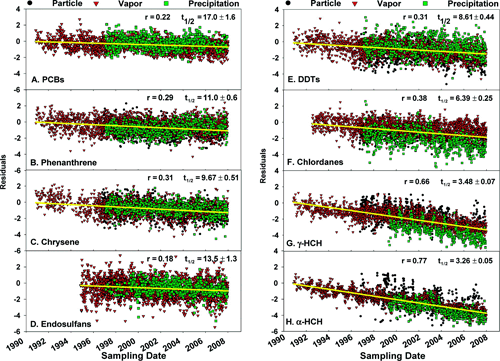With almost 20 years of collected data, one of the more interesting aspects of Integrated Atmospheric Deposition Network (IADN) is the analysis of long-term spatial and temporal trends of Persistent Organic Pollutants (POP) concentrations in the Great Lakes basin. Our latest approach to the analyses of the temporal trends in POP concentrations includes harmonic multiple regression allowing combining concentrations for a specific compound or group of compounds in all three phases (vapor, particle, and precipitation) at all IADN sites together via calculating partial residuals of actual concentrations. This allows us to integrate the data from all phases and sites, giving us a better overall depiction of the behavior of these chemicals in the Great Lakes region.
This relatively simple approach indicated that the concentrations of PCBs in air around the Great Lakes are decreasing with an overall halving time of 17 ± 2 years, which is slow for a substance that was banned about 35 years ago. Phenanthrene, chrysene, and endosulfan showed halving times on the order of 10 years. The concentrations of several organochlorine pesticides were decreasing more rapidly; for example α- and γ-HCH (lindane) have halving times of about 3.5 years.
It is somewhat surprising that, 40 years after it was banned, α-HCH is still present in the environment despite a relatively rapid elimination rate. Clearly, technical-HCH was heavily used in its heyday. The rapid halving times observed for α-HCH and γ-HCH(lindane) are consistent with the relatively high volatilities of these chemicals.
Get more details

